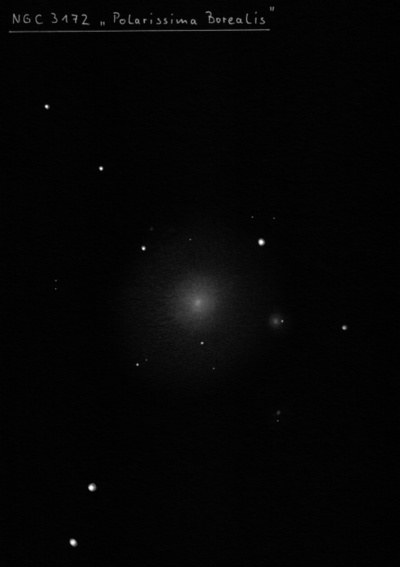
John Herschel discovered NGC 3172 = h250 on 4 Oct 1831 and recorded "vF; R; gbM; 25"; has a * 11m 2' S. This nebula is remarkable for its proximity to the pole. Owing to this the RA cannot be determined exactly, and the PD is open to correction." In the synonym column he called it "Polarissima" but later it was called "Polarissima Borealis" to distinguish it from "Polarissima Australis". Heinrich d'Arrest observed it with the 11" refractor at Copenhagen on 12 Aug 1866. He noted the mag 12 star is 75" distant to the north. At the time of discovery in 1831 this galaxy was only 4.5' from the north celestial pole!
400/500mm - 17.5" (7/16/93) : faint, very small, round, 0.5' diameter, very small brighter core, faint stellar nucleus. A mag 13 star is 1.5' NW. This is the closest NGC galaxy to the North Celestial Pole and is known as "Polarissima Borealis".
17.5" (11/14/87): very faint, small, round, brighter core, faint stellar nucleus, can hold steadily with averted. A mag 12.5 star is 1.5' distant.
17.5" (8/1/86): faint, brighter core, fairly small, round. A mag 13 star is within 2'.
600/800mm - 24" (9/6/18): at 375x; fairly faint, fairly small, round, 30" diameter, very small brighter core that occasionally sharpens up to a quasi-stellar nucleus. A mag 12.5 star is 1.5' (NW). MCG +15-01-010, situated just 1.5' (WSW), appeared extremely faint, very small, round, 18" diameter, low even surface brightness.
24" (9/15/12): fairly faint, small, round, 25" diameter, well defined halo, broad weak concentration with a very small brighter nucleus. A mag 13 star is 1.5' distant (NW) and a very faint mag 16.5 star is 50" S.
900/1200mm - 48" (10/26/16): at 375x and 488x; fairly bright, moderately large, round. Sharply concentrated with a very bright round core that increases to the center and a low surface brightness 45" halo. A mag 12.5 star is 1.5' separation (NW) and a mag 16-16.5 star is within 1' (50" S).
MCG +15-01-010, at 1.6' separation (WSW), appeared fairly faint, fairly small, ~35" diameter, slightly elongated, weak concentration. Visible continuously with direct vision though fairly low surface brightness. A mag 16.7 star is 16" W at the edge of the halo. 2MASX J11503836+8907109, at 1.8' separation (NNE), appeared extremely faint and small, ~6" diameter. A mag 15.7 is 25" away. At 610x, the galaxy popped as a thin, low surface brightness edge-on, ~20"x6".
Notes by Steve Gottlieb